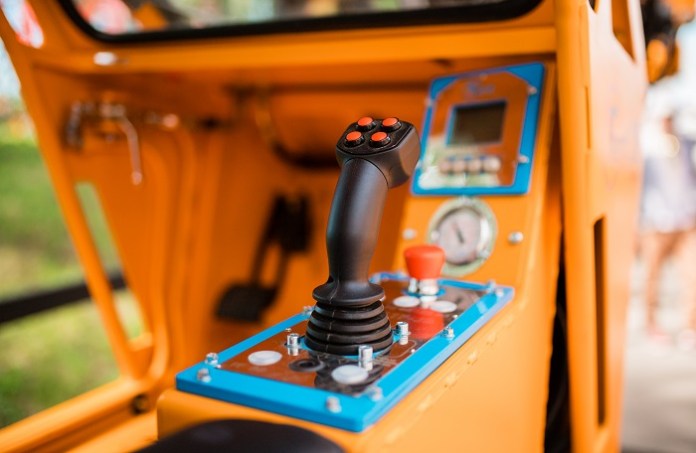When operating industrial machinery, precision and accuracy are vital to a productive and safe working environment. Commonly, joysticks are used to aid in the maneuvering of heavy equipment for a variety of industries, including construction and agriculture. They serve an invaluable role in the ease of use and overall performance of the machine. By maximizing the reliability of their joysticks, companies can reduce downtime and save money in the long term.
There are two major types of industrial-grade joysticks. Potentiometer joysticks are an established technology that operates through the analog output of an electronic circuit. Hall-effect joysticks use sensors to detect positioning through a small magnetic field. Hall-effect joysticks are frictionless and don’t experience wear and tear from contact with the sensor.
Hall effect was originally an industrial-grade technology, but it is starting to gain popularity in commercial-grade applications like video game controllers. Here, we’ll explain the technology and applications in which Hall effect may make a better joystick.
How does Hall-effect sensor technology work?
Named for the physicist who discovered it, the Hall effect establishes the principle that a magnetic field introduced to a conductor or semiconductor with a perpendicular current creates a voltage that can be measured at the resulting right angles. Hall-effect sensors are solid-state devices. They utilize magnets to detect the direction and strength of a magnetic field, translating encoded information into electrical signals and allowing them to be processed by electronic circuits.
Magnetic fields have two primary components: flux density and polarity. Hall-effect sensors produce an output signal, which is the function of the surrounding magnetic field density. When the density surpasses a preset threshold, the device creates “Hall voltage,” an output voltage that is proportional to the potency of the magnetic field. These sensors have coverage to detect speed, proximity and positioning.
Hall-effect versus potentiometer joysticks
- Unlike the magnets of the Hall-effect joystick, potentiometer joysticks contain moving parts that can alter the resistance level of an electronic circuit.
- Hall-effect joysticks do not require contact with the sensor. This means that they are not as prone to mechanical wear and tear over time.
- While potentiometer joysticks are a great choice for precision work, Hall effect is ideal for uses that create significant vibration and shock.
- One potential drawback of the Hall-effect sensor, as opposed to the potentiometer, is that it is less flexible when it comes to voltage availability. This can limit the type of application it can be installed for.
- The conditions that cause joystick drift. Hall-effect sensors are more resistant to vibration and shock but less resistant to temperature changes.
Budget, lifespan and operating environment are the primary considerations for selecting the right technology for the application. Hall-effect joysticks may be better on equipment like mining trucks and excavators that can keep precise positioning when exposed to heavy vibration and shock during use. But potentiometer joysticks may be better for joysticks with greater exposure to the elements or expected to operate in environments with temperature extremes.
Commercial applications for Hall-effect joysticks
The most prominent commercial use of joysticks generally is in gaming. While controllers have traditionally included potentiometer (analog) joysticks, Hall-effect joysticks are revolutionizing console gaming by eliminating “stick drift.”
Joystick drift means a joystick controller becomes less precise over time. These controllers can even detect input where there is none, causing an in-game target reticle or character to “drift” out of its intended position. It’s a fairly common defect in potentiometer joysticks, especially after exposure to vibration, strong impact or even just many hours of use.
Hall-effect joysticks can improve commercial-grade controllers in the same way they benefit industrial-grade ones. Frictionless sensors mean they won’t wear down even after many hours of use, and they are unlikely to develop drift after vibration or impact.
There are options available or in development for all major console platforms, including Xbox, Nintendo, PC and PlayStation.
Are Hall-effect joysticks better than potentiometer joysticks?
The answer is generally yes. Unless you expect to regularly expose the Hall-effect joystick to extreme temperatures, it will likely operate with precision over a much longer lifespan. However, they may cost more and might not be available for certain devices or applications.
Advertisement






